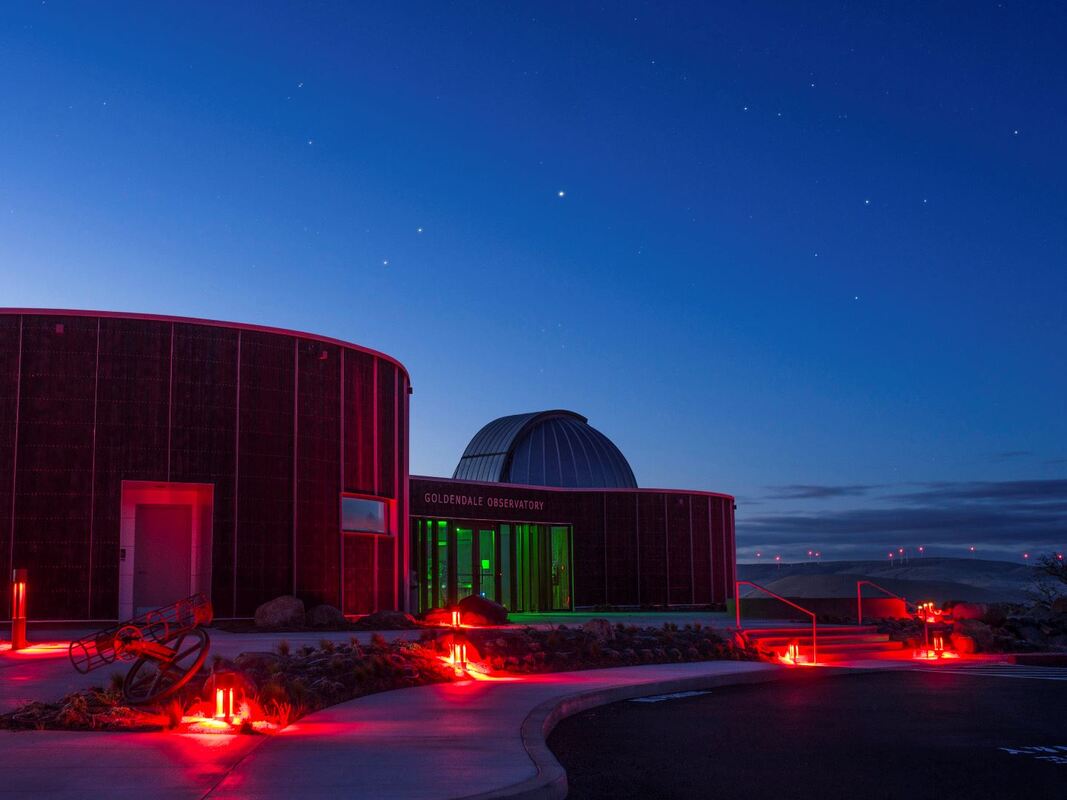|
GOLDENDALE OBSERVATORY
Attractions
Set in the hills above the Columbia River, Goldendale Observatory State Park houses one of the nation’s largest public telescopes. The newly-renovated facility is known for informative science programs and vivid starry skies.
By day, enjoy panoramic views of stunning scenery from all corners of the park. Within the historic observatory domes and expansive new classroom, afternoon and evening visitors can explore our sun, other stars, planets, and all the deep sky has to offer. Live telescope views are offered during all programs (weather permitting).
The Observatory is conveniently located near popular camping State Parks like Brooks Memorial, Maryhill, and Columbia Hills. Other area attractions include the Maryhill Museum of Art and WWI Stonehenge Memorial.
By day, enjoy panoramic views of stunning scenery from all corners of the park. Within the historic observatory domes and expansive new classroom, afternoon and evening visitors can explore our sun, other stars, planets, and all the deep sky has to offer. Live telescope views are offered during all programs (weather permitting).
The Observatory is conveniently located near popular camping State Parks like Brooks Memorial, Maryhill, and Columbia Hills. Other area attractions include the Maryhill Museum of Art and WWI Stonehenge Memorial.
History
Working in the 1960s, four amateur astronomers—Mack McConnell, John Marshall, Don Conner and Omer VanderVelden—built the 24-inch Cassegrain reflecting telescope that is housed at Goldendale Observatory. The men, only one of whom had a college degree, began their project in an astronomy club at Vancouver's Clark College. They spent more than six years designing and assembling the telescope and grinding the glass for its mirror, spending only $3,000 on materials.
Due to light pollution and persistent cloud cover, Vancouver was not an ideal location for astronomical observation. The group set out to find a more suitable location for their telescope. As part of their search, Marshall and his wife made a trip to eastern Washington with Don Conner and stopped to east lunch at a café in Goldendale. They mentioned their project to the café's owner who arranged for them to meet with the town's mayor, George Nesbitt. Eventually, a proposal was developed to create an observatory and science center with a mission of furthering public astronomy education. Funding for construction of the observatory was provided by donations, a federal grant and a bank loan. The observatory was dedicated as a public education center on October 13, 1973.
On February 26, 1979, Goldendale Observatory served as the National Astronomical League's headquarters during a solar eclipse. An estimated 15,000 people showed up to watch the event.
The Goldendale Observatory Corporation, a non-profit, volunteer organization, operated the facility through 1980, when the observatory was acquired by the Washington State Parks and Recreation Commission. The park is one of the largest public observatories in the nation.
Due to light pollution and persistent cloud cover, Vancouver was not an ideal location for astronomical observation. The group set out to find a more suitable location for their telescope. As part of their search, Marshall and his wife made a trip to eastern Washington with Don Conner and stopped to east lunch at a café in Goldendale. They mentioned their project to the café's owner who arranged for them to meet with the town's mayor, George Nesbitt. Eventually, a proposal was developed to create an observatory and science center with a mission of furthering public astronomy education. Funding for construction of the observatory was provided by donations, a federal grant and a bank loan. The observatory was dedicated as a public education center on October 13, 1973.
On February 26, 1979, Goldendale Observatory served as the National Astronomical League's headquarters during a solar eclipse. An estimated 15,000 people showed up to watch the event.
The Goldendale Observatory Corporation, a non-profit, volunteer organization, operated the facility through 1980, when the observatory was acquired by the Washington State Parks and Recreation Commission. The park is one of the largest public observatories in the nation.
